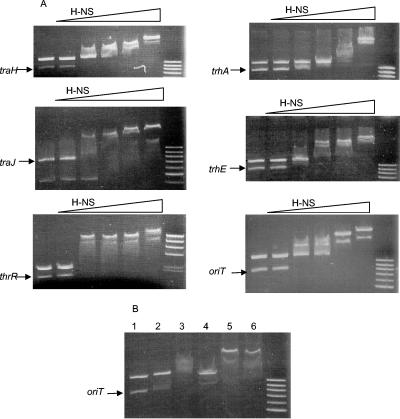FIG. 3.
(A) Effect of increasing amounts of H-NS protein (0.1625, 0.325, 0.4875, 0.65, and 1.3 μg) on the electrophoretic mobility of DNA fragments corresponding to the promoter regions of the traH, traJ, and trhR (Tra1) genes, the trhA and trhE (Tra2) genes, or the oriT region. Arrows point to the R27 DNA fragment used in each test. (B) Effect of H-NS protein plus Hha protein on the electrophoretic mobility of a DNA fragment corresponding to the oriT region. Lane 1, no protein added; lane 2, Hha protein added (48.44 μg); lane 3, Hha protein (48.44 μg) and H-NS protein (0.325 μg) added; lane 4, H-NS protein (0.325 μg) added; lane 5, Hha (48.44 μg) and H-NS (0.65 μg) proteins added; lane 6, H-NS protein (0.65 μg) added. As nonspecific competitor DNA, an S/E (in thrR assay), S/P (in traH, trhA, trhE, and oriT assays), or S/H (in traJ assay) fragment corresponding to the upstream regulatory region of the hly operon of plasmid pHly152 was used (see text for details). The DNA standard used was a 100-bp ladder (Biotools) in all cases, except for the thrR assay, where λ/HindIII (Biotools) was used.

